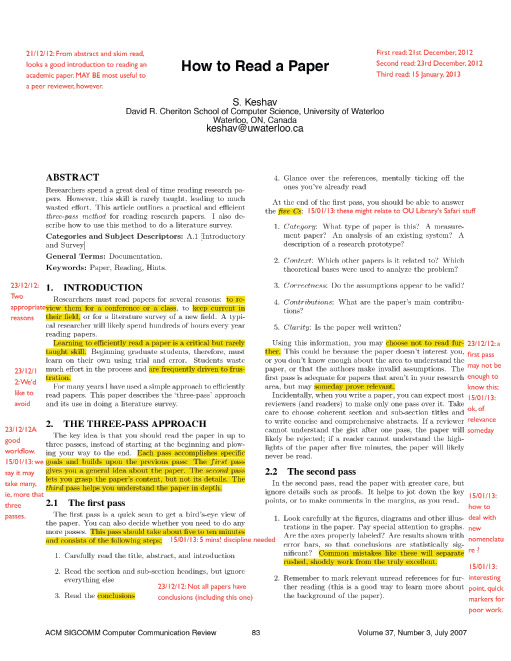8.1.3 Assimilating an academic article
Some of the most challenging information resources that exist come from the academic literature: even the most experienced researcher will not expect to read an academic paper once and immediately understand it. Accordingly, the workflow for assimilating the information is complex. In this subsection you will explore this complexity by using a workflow suggested by the author of the paper you have just ‘discovered’.
The barriers to understanding a paper are many and high. An academic paper is considered good if it makes a contribution to knowledge; therefore, to understand an academic paper is to understand the contribution to knowledge that it makes. This may require a substantial investment of time and be very challenging.
Understanding an academic (or other) article may require you to understand a new concept or new terminology, to look at an existing model, concept or ‘thing’ from a new perspective, or to see a group of things in a new relationship. Accomplishing tasks such as these will very probably take more than one reading.
If you were on holiday – for instance – you might be able to dedicate a full weekend or a week to an academic article and read it through as many times as you need. However, you will probably not always be able to dedicate a block of time to the many readings an individual academic paper might need, and so you must find a way of recording your understanding of a paper from one reading to the next.
Annotation
Here are the annotations we made on the published version of Keshav’s paper. They appear in red and as electronic highlights in yellow.
Activity 17
By looking at the text of the notes, identify and list the three dates on which the paper was read. What do you think we were trying to convey with the annotation?
Discussion
The dates are:
- First read: 21 December 2012
- Second read: 23 December 2012
- Third read: 15 January 2013
The notes appear to record observations on the workflow, and any differences from what the reader had expected. For instance, in two cases an initial note is followed up with a further note. The first case has:
- ‘23/12/12: A good workflow.’
followed up by:
‘15/01/13: we say it may take many, i.e., more that [sic] three, passes.’
The second note has:
- ‘23/12/12: a first pass may not be enough to know this.’
followed up by:
- ‘15/01/13: ok, of relevance someday.’
The first pairing of notes suggests that in the reader’s experience, you sometimes have to read an academic paper several times before you really understand it.
The second pairing of notes shows the reader’s growing understanding of what the purpose of the first pass is.
Keshav (2007) advocates following a workflow for reading an academic paper. There are three passes to this workflow, and the subsections that follow will examine these as a way of assimilating the information presented.

